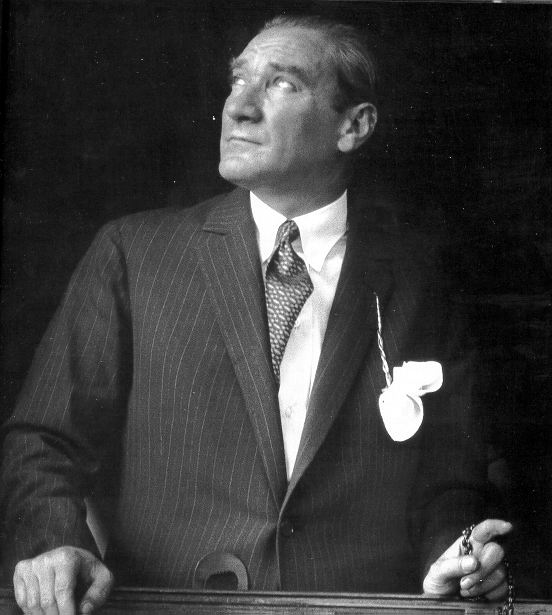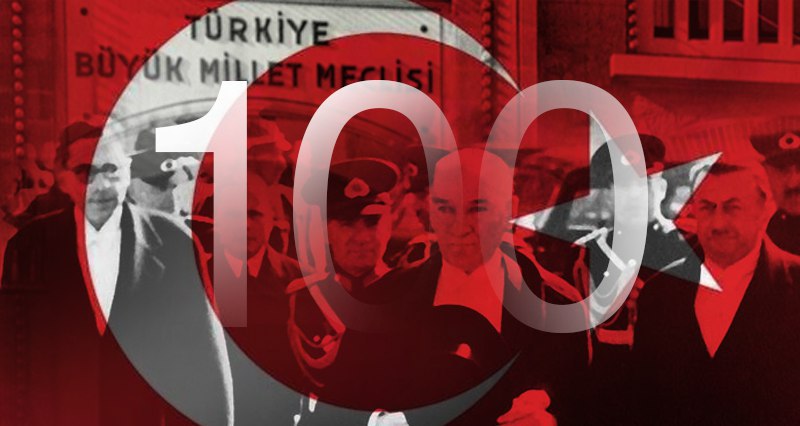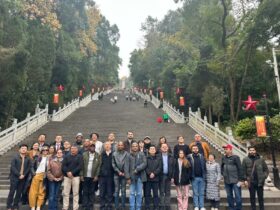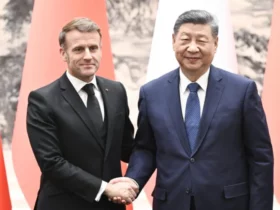By Emrah Alan
Today is the 100th anniversary of the establishment of the Grand National Assembly of Turkey. 100 years ago, the National Assembly banded together around Mustafa Kemal in the midst of a life and death struggle. After the Turkish war of independence, Turkey became the center of social revolutions which affected nearly all the oppressed nations struggling against imperialism. In memoriam of this important day, we have decided to publish some research into the relationship between the Turkish revolution led by Mustafa Kemal and the Chinese revolution.
The framework of the study
There were more than 750 relevant news articles published between the years of 1919-1949 between 35 different newspapers, 32 of these newspapers were published in Chinese, while 3 were published in English. The first news item related to Mustafa Kemal to hit China was published in The China Press in English in 1919. Originally taken from the New York Times, it covered the situation in Anatolia. The first Chinese-language news article about Mustafa Kemal was published on Shenbao (申报) in 1923 in Shanghai, titled “土耳其问题之地理解释” which we might translate into English as “A Geographical explanation of the situation in Turkey”.
The China Press 1919.11.20

Dagong Wanbao(大公晚报)1949.11.12 – The Sick Man of East has become strong and healthy

Shenbao(申报) 1923.03.04 – The Geographical explanation of Turkey’s

The list of the newspapers
- 申报 (上海-香港)(Shen Bao- Shanghai and Hong Kong editions) (197 News) Shen Bao was first published in Shanghai in 1872. It was suspended on May 1949. It was the longest-running newspaper with wide social influence in modern China and the symbol of the beginning of modern newspapers in China. It has been in operation for 77 years. It has gone through three eras: the late Qing Dynasty (晚清), the Beiyang Government (北洋政府) and the National Government (民国政府). Its publication time is long and its influence is wide which other newspapers were hard to reach. It occupies an important position in the study of Chinese Journalism history and social history.
- 大公报 (Dagong Bao) (7 Different version (Hong Kong, Tianjin, Shanghai etc., in total 144 news) Dagong Bao is one of the oldest Chinese newspaper in China. It was founded in Tianjin in 1902. Dagong Bao supported the Guomindang at the beginning of the Civil War, but later on it has switched its sympathies to the communists. But actually, it has suggested the third way that called 《自由主义者的信念》 (Faith of the liberals)
- The China Press (大陆报) (141 news) China Press was published in Shanghai in 1911 and it is the earliest American-style newspaper in Shanghai, which is popular among readers.
- 中央日报 (The Central Daily- Shanghai and Chongqing editions) (62 News) The Central Daily News is Guomindang official newspaper. It was published in Shanghai by the Guomindang (国民党) Central Committee in February 1928. And here you can see an article series that called “灰色狼凯末尔”. The meaning of this; “The Gray Wolf Kemal”. This article series just contained a Chinese translation of some parts of the Mustafa Kemal`s biography written by Armstrong which called Gray Wolf: The Life of Kemal.
- The North-China Daily News (1864-1951) (29 news) The North China Daily News, also known as the Zilin News was one the most influential English newspaper published in China. The oldest English newspaper ever published by the British in China which founded in Shanghai in 1850. The newspaper has made a lot of comments about interfering in China’s internal affairs. The main readers were foreign diplomats, missionaries and businessmen in China.
- 新闻报 (Xinwen Bao) (20 News) Newspaper was first published in 1893. During Anti-Japanese Resistance War (抗战); after the invasion of Shanghai by the Japanese army, the newspaper accepted Japanese news inspection and stopped publishing any reports on the struggle of Chinese people’s anti-Japanese and national salvation.
- 西北文化日报 (Northwest Culture Daily) (19 News) This newspaper also very important because that advocated joint resistance against Japan`s, supported the CPC’s national united front policy, reported on the progressive cultural activities in Northwest China, and exposed the Guomindang’s (国民党) non-resistance policy.
- 京报 (Jing Daily) (19 News) Beijing Daily was originally a semi-official Chinese journal, published in Beijing by the Qing Dynasty, also known as “Di Bao 邸报”.
- 南宁民国日报 (Nanning Minguo Ribao) (15 News)
- 西京日报 (Xijing Ribao) (13 News) “Xijing Daily” is the official newspaper published by the Propaganda Department of the Guomindang (国民党) Central Committee in Xi’an in 1933.
- The North-China Herald and Supreme Court & Consular Gazette (1870-1941) (13 News) One of the oldest English newspaper in the China that has published in Shanghai. It mainly publishes commercial materials such as advertisements, quotes and shipping schedules. It also publishes speeches, Chinese and foreign news and announcements from British and foreign diplomatic and commercial authorities in Shanghai. To some extent, it reflects the views of the British government so that it has regarded as the “British official newspaper.”
- 工商日报-西安 (Industrial and Commercial Daily – Xi’an) (12 News)
- 益世報 (Yishi Bao) (9 News) Yishi Daily, one of the most famous newspaper in Tianjin, it is a Chinese daily published in China by the Roman Catholic Church. It has founded in Tianjin on October 10, 1915. From the 1930s to the 1940s, Yishi Bao adhered to the liberal tendencies. It opposed to Guomindang, did not understand the revolutionary movement of the Communist Party, and wavered in the middle of the political tendencies.
- 新天津 (Xin Tianjin) (9 News)
- 新华日报 (Xinhua Daily- New China Daily) (7 News) Xinhua Daily was the first large-scale organ newspaper of the Communist Party of China in the period of the Anti-Japanese War and the early period of the Liberation War. It was founded by Zhou Enlai(周恩来) and was the first publicly issued by the Communist Party of China in the whole country. The newspaper lasted until February 1947.
- 解放日报 (Liberation Daily) (6 News) This newspaper, based in Shanghai, which stared publishing in 1941, is also one of the major media organs of the Chinese Communist Party during that period.
- 民國日報 (Republic of China Daily) (6 News)
- 华北日报 (North China Daily News) (6 News)
- 晨报 (Chenbao) (3 News)
- 社会日报 (Shehui Ribao) (3 News)
- 甘肃民国日报 (Gansu Daily) (2 News)
- 青海民国日报 (Qinghai Daily) (2 News)
- 新天津画报 (Xin Tianjin Hua Bao) (2 News)
- 儿童日报 (Children`s Daily) (1 New)
- 福建日报 (Fujian Daily) (1 New)
- 国风日报 (Guofeng Daily) (1 New)
- 湖南妇女报 (Hunan Women`s Daily) (1 New)
- 晶报 (Jing Bao) (4 News)
- 力报 (Li Bao) (2 News)
- 民众小报 (Minzhong Xiaobao) (1 New)
- 西安晚报 (Xi’an wanbao) (1 New)
- 绥远西北日报 (Suiyuan Northwest Daily) (1 New)
- 西康国民日报 (Xikang Minguo Ribao) (1 News)
- 新疆日报 (Xinjiang Ribao) (1 New)
- 燕京报 (Yanjing Bao) (1 New)
Xinwen Bao 新闻报

The content of this study
Our study looked at 750 news that can be divided into four different categories.
⦁ Curiosity regarding Mustafa Kemal’s life
These articles include articles explicitly about Mustafa Kemal, discussing his daily life, biography, achievements, struggles, strategies, valor, leadership, political tendencies, the news of his death, etc.
These news articles are mostly written with great curiosity and interest. The aim of the writers is to pass on some parts of the life of the great leader and enable the Chinese people to recognize Mustafa Kemal and learn from his life experiences.
Private life of Kemal – Gansu Daily (甘肃民国日报)-1936

⦁ Mustafa Kemal in standard news articles
These articles are sometimes only indirectly related to Mustafa Kemal and are mostly traditional political news stories. For example; The King of England came to Ankara and met with Mustafa Kemal, reports from the war, parts of one of Mustafa Kemal`s speeches.
These news items mostly came from Reuters, the Associated Press and similar news services and translated into Chinese. Some news is taken from English or American newspapers and then translated into Chinese.

⦁ Kemal and China
In my opinion, these are the most important and valuable articles. These articles contain political analysis of China, writings about world politics, articles about the Turkish War of Independence and some consideration about Japanese invasion and the resistance war (抗战) against Japan.
These news stories generally look at the current situation in China and offer potential solutions. The articles often invoke Mustafa Kemal and his establishment of the Republic of Turkey as an example for China to follow in attempting to overcome its own problems. In these reports, Mustafa Kemal’s name is usually mentioned in only one or two sentences in the middle or at the end. The reasoning behind this is rather important, and I will return to the topic at the end of this article.
How to revive the Chinese nation? – Dagong Bao Tianjin Edition 1934.01.04

⦁ Advertisements
There are more than 15 news articles that contain advertisements for books about Mustafa Kemal or radio programs about his life. What is there to take away from these advertisements? If one were living in Shanghai in the 1930s, you could have bought the biography book of Mustafa Kemal, written by Xing Mo Qing, for 1 jiao 5 fen, a fraction of a contemporary Yuan. The book was published in August 1933, and within six months, a second edition was published. This indicates that there was a lot of public interest in Kemal.
Another biography was written by Gu Sen Qian and cost 4 jiao. This biography was written in 1935 and had a broader scope than previous biographies.
Biographies of Mustafa Kemal written in China started to come out in the second half of the 1920’s. In the 1930s, it is clear that readers’ interest dramatically increased which led to an increase in titles on the topic. We also observed that the number of news articles about the new Turkish state and Mustafa Kemal increased during the 1930s.
Written by Xing Mo Qing 邢墨卿

Written by Gu Sen Qian 顾森千

⦁ Review
73 of the news articles we looked at were published between the years of 1919-1923 during the Turkish War of Independence. Almost all of these reports are in English.
90 of the articles were published between 1924 and 1930. During this period, Turkey was busy instituting reforms in nearly all areas, from the life of the people to state administration under the leadership of Mustafa Kemal. After these reforms, Turkey began to develop at a rapid pace, which Western countries referred to as “the Turkish Miracle”.
There were 240 news articles published between 1931 and 1936, an increase of more than 250% compared to the previous period. In my opinion the increase is due to the fact that Chinese scholars, politicians, soldiers, nationalist and communists became interested in closer relations with Turkey due to their mutual opposition to Japanese imperialism directly. After the Mukden Incident (九一八事变), Japan invaded northern China in September 1931 by Nekka Sakusen (The Japanese call the attack Operation Nekka, while the Chinese refer to it as the Defense of the Great Wall长城抗战) in 1933. The Red Army began “the Long March” (长征) in the 1934, in which a major strategic section of Chinese Workers and Peasants serving the Red Army succeeded in reaching their revolutionary base in northern Shaanxi after traversing eleven provinces and covering 12,500 kilometers in the course of a year.
Turkey had fought against a foreign invasion less than a decade before defeating the Greek Army which was being supported by the imperialist countries. In the following years Turkey became one of the most powerful nations in Europe. The Chinese looked to Turkey’s example in their own fight against Japanese imperialism, and became especially interested in Mustafa Kemal. The Chinese started to use Mustafa Kemal’s name in their advertisements to gain support in their own fight.
One advertisement begins with the latest news from the ongoing war, criticizing those who “do not join the résistance against the Japanese” before calling on young people to join the revolutionary army.
…且为复兴中国之凯末尔, 统兵北上抗日。
The united army marched north to resist the Japanese, reviving the spirit of Kemal in China.
Dagong Bao Tianjin Edition 1933.04.27

There are 317 news items from between the years 1937 to 1945, a period which historians refer to as the “Second Sino- Japanese War.” Much of this news was published in 1938, related to Kemal’s worsening health and eventually death.
There are 25 news items from between the years 1946 and 1949. The main reason for the decrease in news related to Kemal was likely that China had successfully repelled the Japan invasion in 1945, and that the so-called “Turkish Miracle” had begun to wane.
On the other hand, both sides still directed much attention toward Kemal’s reforms, particularly surrounding questions of women’s rights, children’s rights and cultural reforms, all of which China was struggling to enact.

Conclusion
The Japanese invasion pushed China to seek solutions and salvation. There were two “sick men” in Asia in the early 20th century: the Ottoman Empire and China. After WW,1 Turkey had revived itself under the leadership of Mustafa Kemal and advanced swiftly over the course of 15 years, becoming an effective model for every country struggling with imperialism. There are two important aspects to this model: firstly, the Turks were able to save their homeland from the imperialists and secondly, they created a stable modern nation in the imperialist era. As a result, Chinese intellectuals started to take a closer look at Turkey.
When the communists analyzed the Turkish War of Independence, they noted that at the beginning of the Greek invasion, there were effectively two governments in Turkey. One ruled from Istanbul under the control of the imperialist countries and put up no resistance to the invading Greek army, the other one was the revolutionary government led by Mustafa Kemal, which was ready to fight. The communists realized that this was very similar to China’s situation. At the beginning of the Japanese invasion, the Guomindang government maintained an indulgent attitude toward Japan.
On the other side, the communists engaged in an all out war to save their homeland from the imperialist threat. Given that Turkey had recovered and become a powerful country, the communists began to wonder if they might do the same, a topic which is hotly discussed in some of the articles. It is worth mentioning that other examples were also invoked as potential exemplars, such as the Soviet Union and various Chinese historical figures.
Looking at the Guomindang, it is clear that they were also taking a closer look at Turkey, because at that time, Mustafa Kemal was one of the strongest figures in the world,something which the nationalists aspired to in establishing their own dictatorship.
(杭州)驻土大使贺耀组谒蒋院长呈送土总统凯末尔照片后、今晨公毕赴沪返京、(十九日专电)
(Hangzhou) Chinese ambassador to Turkey He Yao Zu visited President Jiang (Jiang Jieshi). After presenting a photograph of Turkish President Kemal to him, he completed his official duties and went to Shanghai (after) after which he will return to Beijing. (19th October 1936 special telegram)
Shenbao 1936

Consequently, we can say that the New Turkey under the leadership of Mustafa Kemal, having won a great victory against an imperialist invasion and successfully instituted major reforms in all areas, became a powerful example for the Chinese in their struggle against the Japanese.
“Our nation wish to revive we have to learn from Turkey” Dagong Bao- 1935
Kemal and Revival of Turkey Shenhui Ribao- 1938
Emrah Alan – Peking University Master’s Degree Student



















Leave a Reply